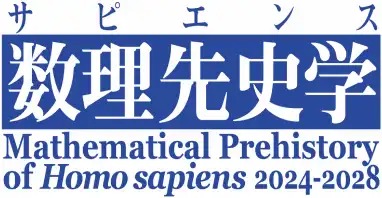Research Overview
Outline of the Research
The major aim of this project is to introduce mathematical modeling in research on the humanities, which is often considered separate from mathematics. As a case study, we apply this methodology to analyze the formation processes of modern human cultures during the extinction of archaic humans 40,000–50,000 years ago.
This subject, which requires considering evidence from various disciplines, serves as a good platform for exercising the application of mathematical modeling to the humanities, in this case, mainly through archaeology. The present study employs the theory of cultural evolution to bridge the gap between mathematical modeling and empirical data from our own global database and fieldwork (Figure 1).

Background of the Research
This project builds on our previous project, “Cultural History of PaleoAsia” (2016–2020), which investigated the formation processes of Paleolithic modern human culture during range expansion. Among the numerous important results including the construction of a continental-scale archaeological database (PaleoAsiaDB), the collaboration between archaeologists and mathematical modelers was particularly impressive. It produced a new cultural evolutionary model, called the “eco-cultural range expansion model, ” which surmised two-stage cultural changes derived from ecological and cultural dynamics during the modern human dispersals (Figure 2).
This experience convinced us that mathematical modeling has great potential for the development of archaeology. Accordingly, we chose the modern and archaic humans replacement issue as a case study of its substantial application because a rich corpus of archaeological data on this subject is already available in Japan mainly from West Asia.

Research Method
To explain archaeological records using mathematical models of cultural evolution, we examine cultural dynamics on two geographic scales: a continental scale over Eurasia (particularly Asia) and a local scale focusing on West Asia.
For continental-scale analyses, we use PaleoAsiaDB as observation data and conduct agent-based simulations to explore the factors (e.g., geography, environment, and cultural transmission) that govern the cultural dynamics over Asia (Figure 3). In the simulations, we also use continental-scale ethnographic and paleoclimate databases. For local-scale analyses, we focus on West Asia, which is an important region for the dispersal of Homo sapiens from Africa to Eurasia. In particular, the Levant region has been inhabited by Homo sapiens since the Middle Paleolithic and is considered the place of origin of the Upper Paleolithic cultures that spread to the surrounding areas (Figure 4).
The results of these studies are interpreted in close collaboration with mathematical modelers to produce a synthetic model for understanding the formation of modern human cultures.


Significance of Mathematical Modeling to Archaeology
Most questions in the humanities and social sciences, such as international relations, political systems, economic stagnation, declining birthrate, and aging population, involve extremely complex factors. In all cases, no simple solution has been found, probably because too many factors and viewpoints are involved. Furthermore, as society’s own will is also involved, it is difficult to provide a simple explanation, and the current situation is requiring a new research framework to deal with complex factors.
The modern and archaic human replacement represents a comparably complex question in human history. A narrative of “modern human superiority” used to suffice as an explanation for the global success of Homo sapiens. However, recent genetic and archaeological studies have suggested more complicated biological and cultural history, indicating interbreeding and cultural interaction. Moreover, it is now clear that although modern humans appeared 300,000 years ago, they only managed to replace archaic humans 40,000–50,000 years ago. In other words, the classic model of “modern human superiority” needs to be seriously reconsidered.
Although we do not provide a direct answer to any modern socioeconomic issues, we expect to provide an example of study of a question involving intermingled factors. Through this attempt, we wish to discuss the possibilities and challenges of mathematical prehistory, which hopefully opens a new avenue to develop humanities studies with mathematical sciences.
